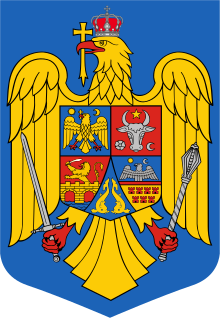Romanian archaeology
Romanian archaeology begins in the 19th century.
Archaeologists
- Alexandru Odobescu (1834—1895)
- Grigore Tocilescu (1850–1909)
- Vasile Pârvan (1882–1927)
- Constantin Daicoviciu (1898–1973)
- living
- Gheorghe I. Cantacuzino (b. 1938)
- Adrian Andrei Rusu (b. 1951) – medieval archaeology,[1] researcher at the Institute of Archaeology and Art History in Cluj-Napoca
Institutes
Museums
Sites
- Acidava (Enoşeşti) – Dacian, Roman
- Apulon (Piatra Craivii) – Dacian
- Apulum (Alba Iulia) – Roman, Dacian
- Argedava (Popeşti) – Dacian, possibly Burebista's court or capital
- Argidava (Vărădia) – Dacian, Roman
- Basarabi (Calafat) – Basarabi culture (8th - 7th centuries BC), related to Hallstatt culture
- Boian Lake – Boian culture (dated to 4300–3500 BC)
- Callatis (Mangalia) – Greek colony
- Capidava – Dacian, Roman
- Cernavodă – Cernavodă culture, Dacian
- Coasta lui Damian (Măerişte)
- Dacian Fortresses of the Orăştie Mountains
- Drobeta (ancient city) – Roman
- Giurtelecu Şimleului
- Histria – Greek colony
- Lumea Noua (near Alba Iulia) – middle Neolithic to Chalcolithic
- Napoca (Cluj-Napoca) – Dacian, Roman
- Peștera cu Oase – the oldest early modern human remains in Europe
- Porolissum (near Zalău) – Roman
- Potaissa (Turda) – Roman
- Sarmizegetusa Regia – Dacian capital
- Sarmizegetusa Ulpia Traiana – Roman capital of province of Dacia
- Trophaeum Traiani/Civitas Tropaensium (Adamclisi) – Roman
- Tomis (Constanţa) – Greek colony
- Ziridava/Şanţul Mare (Pecica) – Dacian, Pecica culture, 16 archaeological horizons have been distinguished, starting with the Neolithic and ending with the Feudal Age
Cultures
- Basarabi culture
- Boian culture
- Bug-Dniester culture
- Bükk culture
- Cernavoda culture
- Chernyakhov culture
- Coțofeni culture
- Cucuteni-Trypillian culture
- Danubian culture
- Dudeşti culture
- Globular Amphora culture
- Gumelniţa-Karanovo culture
- Hamangia culture
- La Tène culture
- Linear Pottery culture
- Lipiţa culture
- Otomani culture
- Pecica culture
- Tiszapolgár culture
- Usatovo culture
- Vinča culture
- Wietenberg culture
- Getae
- Dacians
- Roman
Literature
- Alexandru Odobescu, Istoria arheologiei, 1877
Publications
- Dacia by Vasile Pârvan Institute of Archaeology, published continuously since 1924
gollark: A monoid from an Enum metaclass.
gollark: No.
gollark: I refuse your refusal.
gollark: Lyricly, stop wasting time with nonMacron things.
gollark: Lack of good response interpreted as communism.
See also
- List of Romanian archaeologists
- History of Romania
- Prehistory of Transylvania
- Bronze Age in Romania
- Archaeological looting in Romania
- Dacia
Notes
- "Cetatile medievale, ieri si azi". City News. October 1, 2008.
References
Further reading
This article is issued from Wikipedia. The text is licensed under Creative Commons - Attribution - Sharealike. Additional terms may apply for the media files.
